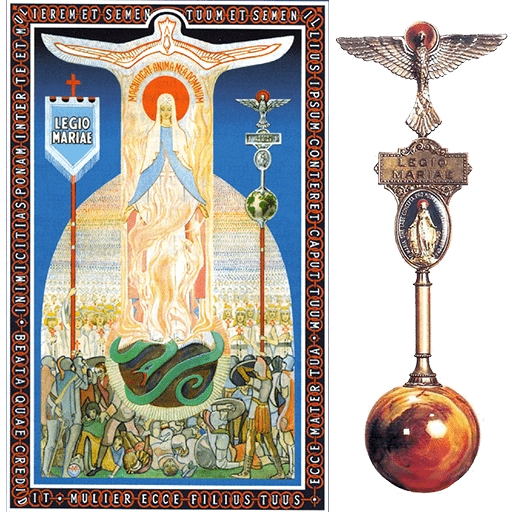June 2023 Allocutio
Mary and the Holy Spirit
Fr. Paul Churchill
Concilium Spiritual Director
Today, just a few weeks after we have celebrated Pentecost and the Blessed Trinity, I’d like to take a closer look at Frank Duff’s theology regarding the relationship of Mary and the Holy Spirit in the context of the Blessed Trinity.
For Frank the Incarnation had to be a work not just of one of the persons of the Holy Trinity but of them all. God sent his only Son, incarnate by the Holy Spirit in the womb of Mary. The person conceived by the Holy Spirit in her womb and who was born, grew up, carried out his public ministry before dying on the Cross, was the Incarnate Son of God. But who is this Mary through whom God would unite with his creation?
St. Francis of Assisi had called Mary the Spouse of the Holy Spirit. Saint Maximillian Kolbe, commenting on the Incarnation, said, “What kind of union is this? It is above all interior; it is the union of her whole being with the being of the Holy Spirit. The Holy Spirit dwells in her, from the first instance of her existence, and he will do so always, throughout eternity … This uncreated Immaculate Conception conceives divine life immaculately in the soul of Mary”
Frank, while agreeing with de Montfort that she has to be totally creature, sees her as being the greatest expression in human flesh of the Holy Spirit. Let us listen to Frank. “As Mary is the Spouse of the Holy Spirit, full of His grace, His inseparable partner in His external mission, it follows that she has become like unto him to the highest extent that a creature can be.” Jesus mirrors to us the Second person (whom he is) and Mary mirrors the Third person. Mary is much more than a channel of the Holy Spirit’s graces; He makes a revelation of himself through her. Frank says that the best expression we have in human form of the Holy Spirit is Mary. God the Father so arranged Creation that Son and Holy Spirit would express themselves respectively in Jesus and Mary.
Frank says, “… the Holy Spirit stopped short of becoming incarnate in her. He left her in all respects a human personality, a pure creature. Her role in the incarnation and redemption was to be a completely human one …she was to act on behalf of all mankind.” But “Mary is made and meant to display to us a likeness to the Holy Spirit analogous to the likeness of Jesus Christ to the second divine person.”
He suggests that in Heaven we may first suffer confusion about Our Lady and the Holy Spirit. Frank Duff seeks to help us understand this more by the use of a modern image. The image of someone on television is not the same as that person but the television helps communicate the appearance and words and bodily expressions of that person. And he says that for us to look at Our Lady is the best image we will get of the Holy Spirit.
Frank takes a step further and says, “In becoming incarnate in Jesus Christ, God has assumed the male form.” And then he adds, lest someone wonder if God has denigrated woman, that God balances everything through Mary. He returns to those words of Genesis, “In his own image he made him; male and female he created them” (Gen 1:27). When the triune God was shaping his plan with a view to the Incarnation, he designed creation to reflect in it all three persons of the Trinity. The female is formed based on the Holy Spirit, the giver of life as we say in the Creed; the male is formed based on the second person of the Trinity.
This accords with a view I have found across both Catholic, Orthodox and Protestant literature: the Holy Spirit is the female dimension in God. This too is reflected in the Book of Wisdom which speaks of God the Creator, then of that man who challenges society so much that they test him with cruelty and then it goes on to speak of Wisdom and keeps referring to her in the feminine. The Holy Trinity, in its arranging of the creation with an eye to the Incarnation, created male and female in the image of the Blessed Trinity; the second person is imaged in the male, the third person in the female. All this so that in the fullness of time the second person will become incarnate in the person of Jesus and the Holy Spirit express himself most fully through Mary.
There are many more implications in Frank’s thought that I won’t go into today. For t moment it will be useful to return to simple doctrine of the Blessed Trinity. All three persons are God. All are equal in dignity. But all have different roles. A world that does not respect the equality of man and woman is not doing justice to God; equally a world which tries to brush out the differences in nature and role between male and female may be cutting across the Holy Trinity.
Clearly what Frank puts before us requires deeper prayer and thinking by the whole Church. To rush in to make decisions as if differences between male and female were mere accidental might not just be to cut across nature but to sin against the Holy Trinity. Frank challenges us to a far deeper thinking, not a superficial going with the latest craze. Let me end with yesterday’s collect at Mass: “O God, who prepared a fit dwelling place for the Holy Spirit in the Heart of the Blessed Virgin Mary, graciously grant that through her intercession we may be a worthy temple of your Glory. Amen.”

